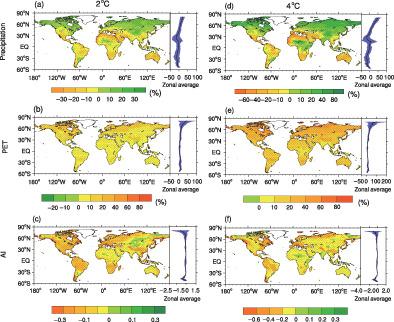当前位置:
X-MOL 学术
›
Int. J. Climatol.
›
论文详情
Our official English website, www.x-mol.net, welcomes your feedback! (Note: you will need to create a separate account there.)
Future changes in Aridity Index at two and four degrees of global warming above preindustrial levels
International Journal of Climatology ( IF 3.9 ) Pub Date : 2020-04-28 , DOI: 10.1002/joc.6620 Xiaoxin Wang 1 , Dabang Jiang 1, 2, 3 , Xianmei Lang 1, 2
International Journal of Climatology ( IF 3.9 ) Pub Date : 2020-04-28 , DOI: 10.1002/joc.6620 Xiaoxin Wang 1 , Dabang Jiang 1, 2, 3 , Xianmei Lang 1, 2
Affiliation

|
In this study, we project the global terrestrial changes in Aridity Index (AI), as defined by the ratio of annual precipitation to potential evapotranspiration (PET), at 2 and 4°C levels of global warming above the preindustrial conditions based on the outputs from 21 Coupled Model Intercomparison Project Phase 5 models under the Representative Concentration Pathways 8.5 (RCP8.5) scenario. Compared to the preindustrial period, the global terrestrial annual precipitation will increase by an average of 0.02% (3%), the annual PET will increase by 6% (15%) and AI will decrease by 0.1 (0.2) at the 2°C (4°C) warming level. More remarkable decreases in the annual AI are seen in the northern high latitudes, where will also experience greater increases in PET and precipitation. In general, the seasonal changes in AI display a similar spatial pattern to the annual changes and are characterized by the greatest decrease in December–January–February and the smallest in June–July–August. The largest expansion of drylands occurs in semi‐arid regions, followed by the expansion of arid regions, with area changes of 4% (7%) and 3% (4%) under the 2°C (4°C) scenario, respectively. Further analyses indicate that the AI changes are determined by PET in the northern high latitudes, and the contribution of PET to AI increases from the 2 to 4°C warming levels. Furthermore, changes in thermodynamic factors contribute most to the PET, and at a higher level of global warming, the contribution of thermodynamic factors increases and that of dynamic factors decreases.
中文翻译:

高于工业化前水平的全球变暖两度和四度下干旱指数的未来变化
在这项研究中,我们根据产量预测了在全球升温2到4°C的水平下,全球干旱指数(AI)的全球变化,该指数由年降水量与潜在蒸散量(PET)的比值定义代表集中度路径8.5(RCP8.5)情景下的21个耦合模型比对项目第5阶段模型。与工业化前的时期相比,在2°C时,全球陆地年平均降水量将平均增加0.02%(3%),年均PET量将增加6%(15%),AI将减少0.1(0.2) (4°C)升温水平。在北部高纬度地区,年度AI的下降更为明显,那里的PET和降水也将出现更大的增长。一般来说,AI的季节性变化显示出与年度变化相似的空间格局,其特点是12月-1月-2月的降幅最大,6月-7月-8月的降幅最小。干旱地区的最大扩张发生在半干旱地区,其次是干旱地区的扩张,在2°C(4°C)的情况下,面积变化分别为4%(7%)和3%(4%) 。进一步的分析表明,AI的变化是由PET在北高纬度地区决定的,PET对AI的贡献从2到4°C的升温水平增加。此外,热力学因素的变化对PET的贡献最大,并且在较高的全球变暖水平下,热力学因素的贡献增加,而动态因素的贡献减少。
更新日期:2020-04-28
中文翻译:

高于工业化前水平的全球变暖两度和四度下干旱指数的未来变化
在这项研究中,我们根据产量预测了在全球升温2到4°C的水平下,全球干旱指数(AI)的全球变化,该指数由年降水量与潜在蒸散量(PET)的比值定义代表集中度路径8.5(RCP8.5)情景下的21个耦合模型比对项目第5阶段模型。与工业化前的时期相比,在2°C时,全球陆地年平均降水量将平均增加0.02%(3%),年均PET量将增加6%(15%),AI将减少0.1(0.2) (4°C)升温水平。在北部高纬度地区,年度AI的下降更为明显,那里的PET和降水也将出现更大的增长。一般来说,AI的季节性变化显示出与年度变化相似的空间格局,其特点是12月-1月-2月的降幅最大,6月-7月-8月的降幅最小。干旱地区的最大扩张发生在半干旱地区,其次是干旱地区的扩张,在2°C(4°C)的情况下,面积变化分别为4%(7%)和3%(4%) 。进一步的分析表明,AI的变化是由PET在北高纬度地区决定的,PET对AI的贡献从2到4°C的升温水平增加。此外,热力学因素的变化对PET的贡献最大,并且在较高的全球变暖水平下,热力学因素的贡献增加,而动态因素的贡献减少。



























 京公网安备 11010802027423号
京公网安备 11010802027423号